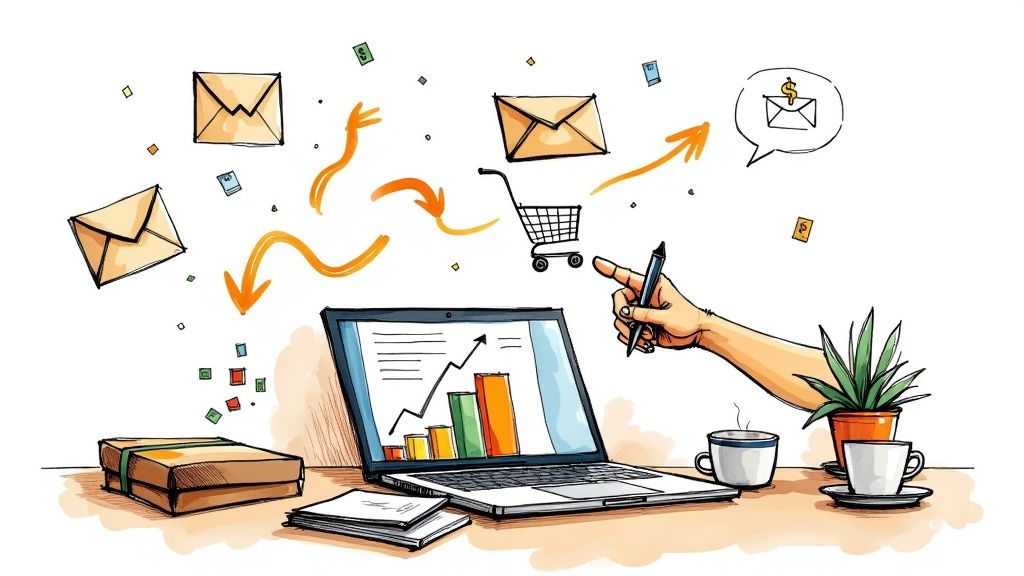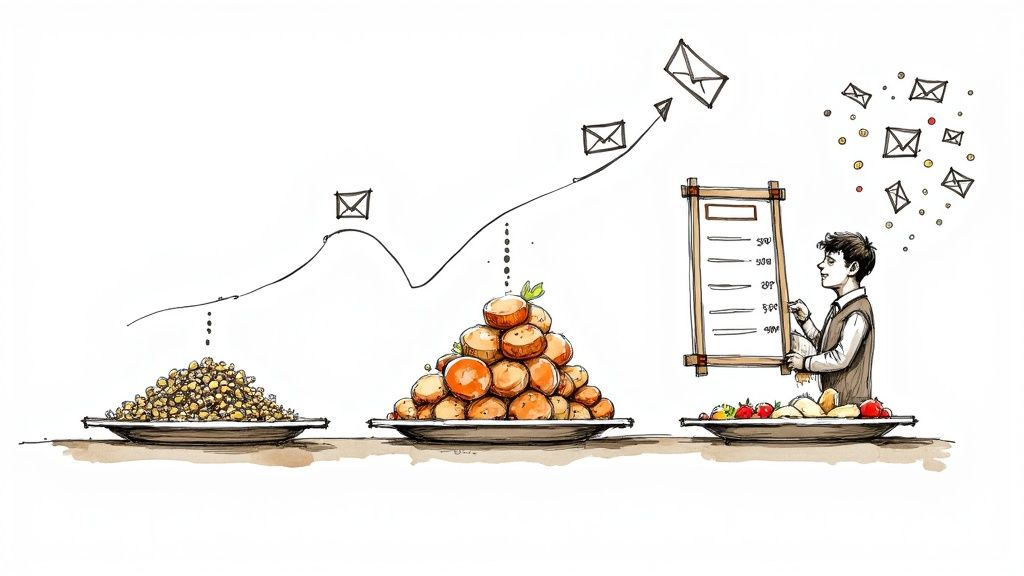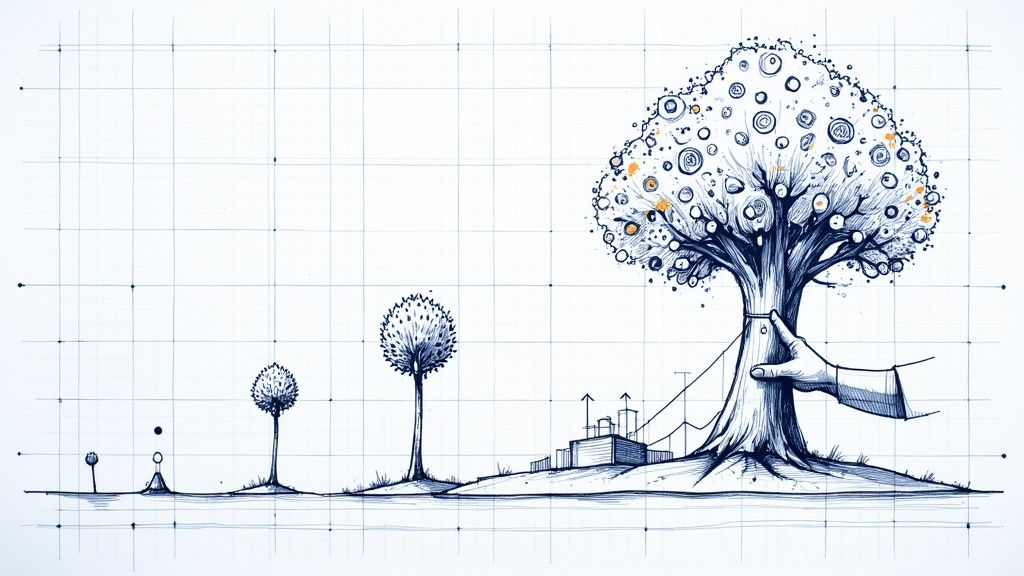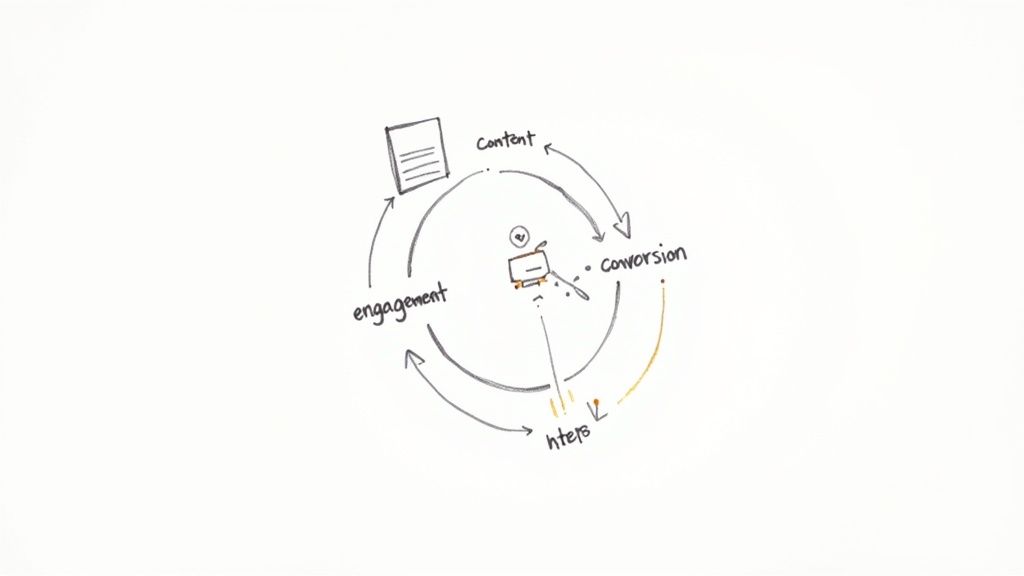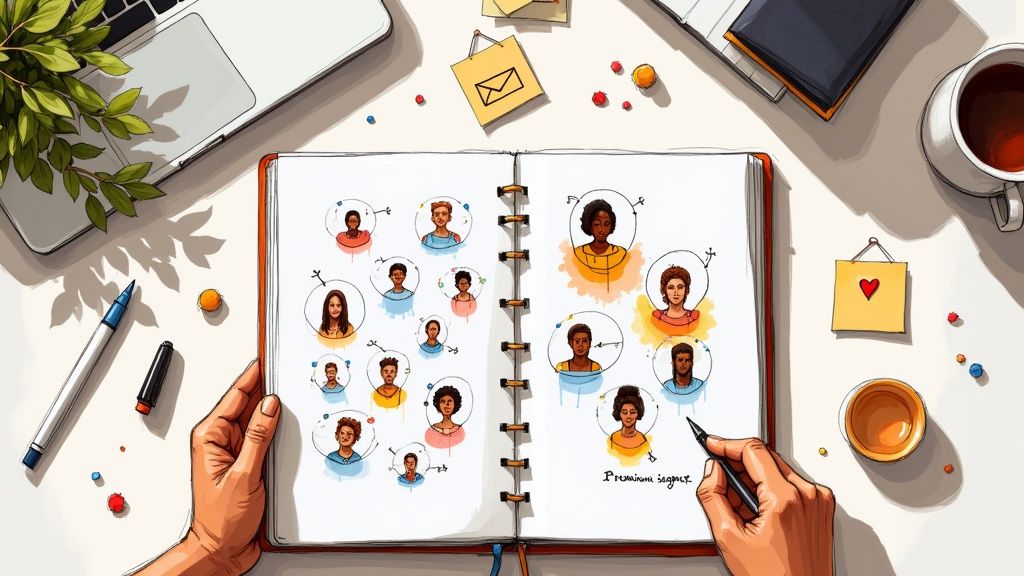How To Increase Customer Lifetime Value Ecommerce: Real Wins
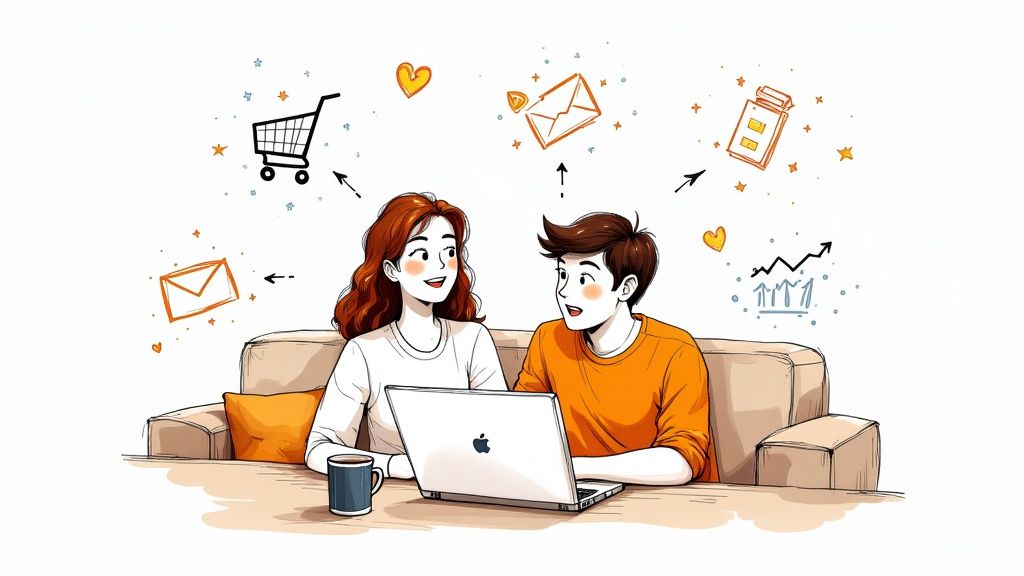
15 mins
6/20/2025
Joe Ervin
- customer lifetime value
- ecommerce CLV
- customer retention
- CLV optimization
Understanding Your CLV Foundation (And Why Most Get It Wrong)
Before diving into the email and social media tactics, we need to get on the same page about something crucial. Everyone talks about how to increase customer lifetime value in ecommerce, but it's a topic where many store owners stumble. They either track the wrong metrics or get so swamped by data they end up doing nothing. This isn't about wrestling with complicated algorithms; it's about grasping the simple math that dictates your store's long-term success.
Getting this right is what separates a brand that grows predictably from one that's always hunting for the next sale. When you really get the pieces of Customer Lifetime Value (CLV), you stop viewing customers as single transactions and start seeing them as long-term relationships. That mental shift makes all the difference.
What Is CLV, Really?
At its heart, CLV is simply a forecast of the total amount of money a customer is likely to spend with your business over their entire time with you. It’s far more than a vanity metric; it’s a strategic compass. The true advantage comes from understanding its basic components.
To boost customer lifetime value in ecommerce, you need to improve a few key numbers. The most direct way to calculate CLV uses a straightforward formula: (Average Purchase Value) x (Purchase Frequency) x (Average Customer Lifespan). For instance, if your skincare brand has an average order value of $60, customers typically buy four times a year, and they stay with you for three years, their CLV is $720. Knowing this helps you make smarter moves, like investing in better support or offering personalized rewards to keep your best customers happy and loyal. You can learn more about these calculations in Shopify’s blog on customer lifetime value fundamentals.
To see how this plays out in different ecommerce sectors, let's look at a few examples. Each business model has unique benchmarks for what makes a "good" CLV.
CLV Calculation Examples by Business Type
Comparison of how different ecommerce sectors calculate and optimize their customer lifetime value metrics
| Business Type | Avg Order Value | Purchase Frequency | Customer Lifespan | Calculated CLV |
|---|---|---|---|---|
| Subscription Box (Coffee) | $40 | 12x per year | 2 years | $960 |
| Fast Fashion Apparel | $85 | 3x per year | 1.5 years | $382.50 |
| High-End Skincare | $120 | 4x per year | 3 years | $1,440 |
| Pet Supplies | $50 | 6x per year | 4 years | $1,200 |
These examples show how CLV isn't a one-size-fits-all number. A fashion brand might focus on increasing purchase frequency, while a subscription service's top priority is extending the customer lifespan.
Why This Simple Math Changes Everything
Knowing the formula is one thing, but using it is where the real growth happens. Every strategy we’ll cover later is designed to move the needle on one of these three variables. If you want to raise your CLV, you have three clear paths:
- Encourage customers to spend more with each purchase (Average Purchase Value).
- Motivate them to come back and buy more often (Purchase Frequency).
- Keep them as a satisfied customer for a longer period (Customer Lifespan).
This simple breakdown shows how these elements work together to define a customer's total worth to your business.
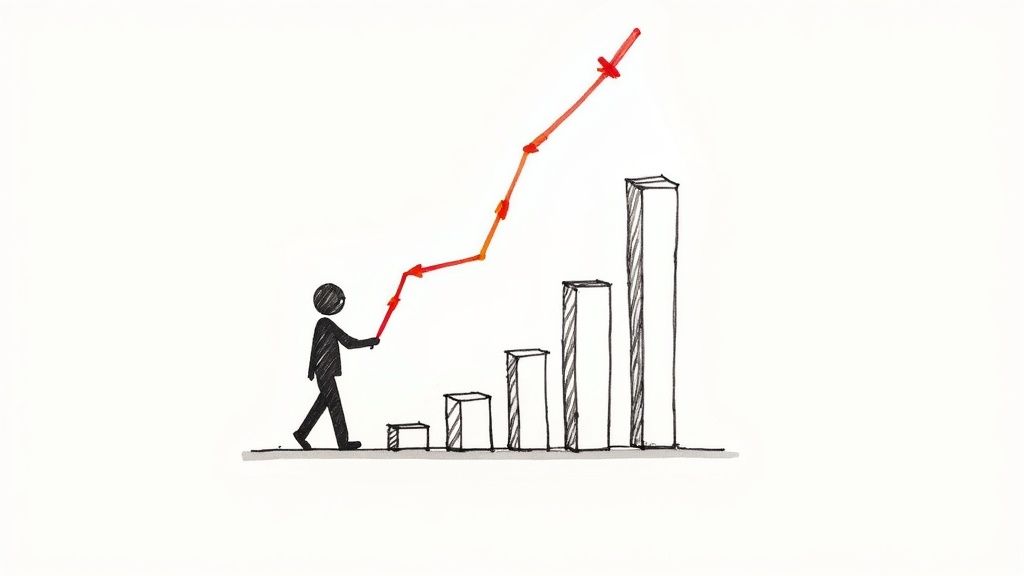
As the image shows, CLV isn’t a fixed number but the dynamic result of these key business drivers. A minor improvement in just one of these areas can have a major effect on your total revenue over time. For example, lifting your average order value by only 15% could bring in more revenue than acquiring dozens of new, low-spending customers. This is the bedrock of smart, lasting growth.
The Retention Breakthrough: Small Tweaks, Massive Results
So many ecommerce brands are stuck on a customer acquisition treadmill, constantly chasing new leads while their existing customer base quietly shrinks. The real secret to sustainable growth isn't just getting more people in the door; it's about convincing the ones already inside to stick around, spend more, and become your biggest fans. This is the heart of increasing customer lifetime value in ecommerce. It's about shifting your focus from a single transaction to building a lasting relationship.
Think about it from your customer's perspective. After they make a purchase, the silence from a brand can be deafening. They've given you their money and trust, and in return, they get... nothing? Or worse, just generic promotional emails. This is a huge missed opportunity. That post-purchase period is your golden window to make a lasting impression and set the stage for a long, profitable relationship.
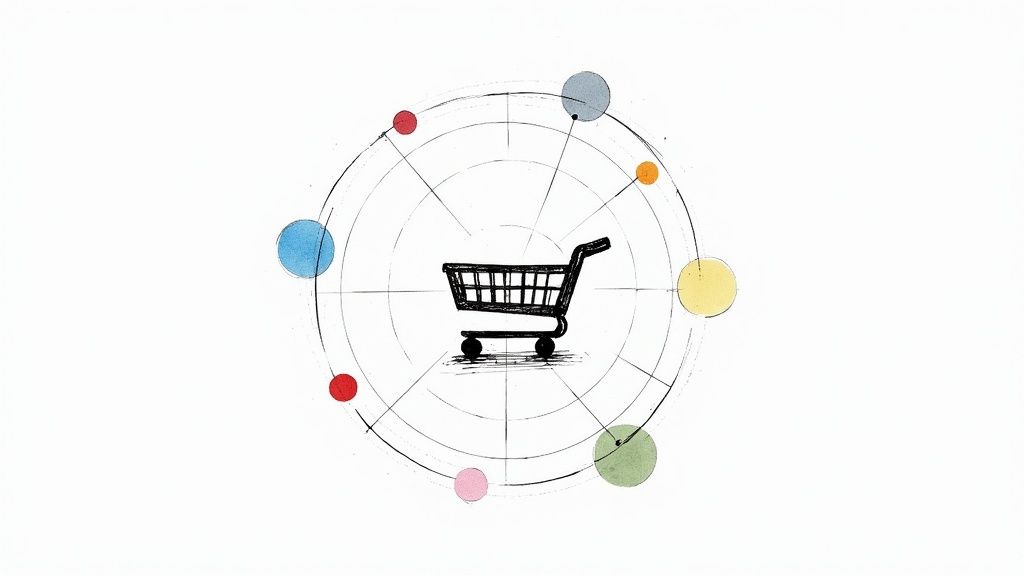
Cracking the Code of Customer Loyalty
Loyalty isn't just about points and rewards programs; it's about psychology. Customers stick with brands that make them feel seen, understood, and valued. This doesn't require a massive budget, just a thoughtful approach to your key customer touchpoints. Small, deliberate actions can have an outsized impact on whether a customer buys from you once or for a lifetime.
The math behind this is incredibly compelling. This isn't just a feel-good strategy; it's a direct path to better profitability. Data shows that even minor improvements in customer retention lead to significant profit boosts. For instance, a mere 5% increase in customer retention can raise profits by 25% to 95%. This happens because loyal customers tend to buy more frequently and spend more over time, directly inflating their CLV. When you extend the average customer lifespan, every other metric gets a lift. Check out these powerful insights on ecommerce customer lifetime value to see how the numbers stack up.
Practical Frameworks You Can Use This Week
Let's move from theory to action. Turning one-time buyers into repeat purchasers starts with a solid post-purchase experience and a genuine reason for them to come back. Here are a few simple frameworks that really work.
- The "Welcome to the Family" Sequence: Instead of a single, boring order confirmation, create a 3-part email sequence that drips out over the first week. The first email confirms the order. The second could share tips on using the product or showcase user-generated content. The third can check in to make sure they're happy. This builds a connection that goes beyond the transaction.
- Surprise and Delight: This is one of the most effective, yet underused, tactics I've seen. A small, unexpected gift with their second order, a handwritten thank-you note, or a surprise free shipping upgrade can create an unforgettable experience. It shows you care, turning a simple purchase into a memorable moment that people talk about.
- Proactive Customer Service: Don't wait for problems to pop up. Use your order data to anticipate issues. If customers in a specific region are seeing shipping delays, send a proactive email acknowledging it and maybe offer a small discount on their next purchase. This approach turns a potential negative into a positive, trust-building interaction.
Identifying and Eliminating Hidden Friction
Sometimes, the biggest obstacle to retention is friction—those small annoyances that make customers think twice about buying from you again. Finding these is crucial for long-term loyalty. A clunky checkout process, confusing return policies, or slow customer service responses are all loyalty killers.
You can uncover these friction points by simply asking your customers through short surveys or by analyzing your support tickets for recurring themes. By smoothing out these rough patches in the customer journey, you make it easy and enjoyable for people to keep coming back, naturally increasing their lifetime value. For a deeper dive, our guide on strengthening ecommerce customer retention offers more ideas.
Benchmarking Reality: Where You Stand and Where Winners Play
Talking about boosting customer lifetime value is one thing, but how do you know if you're actually winning? It's easy to get lost in your own numbers without a clear picture of what "good" truly means in the real world. Without benchmarks, you're flying blind—celebrating small victories that might still leave you miles behind the competition. Let's get real about performance and see what separates the thriving brands from those just getting by.
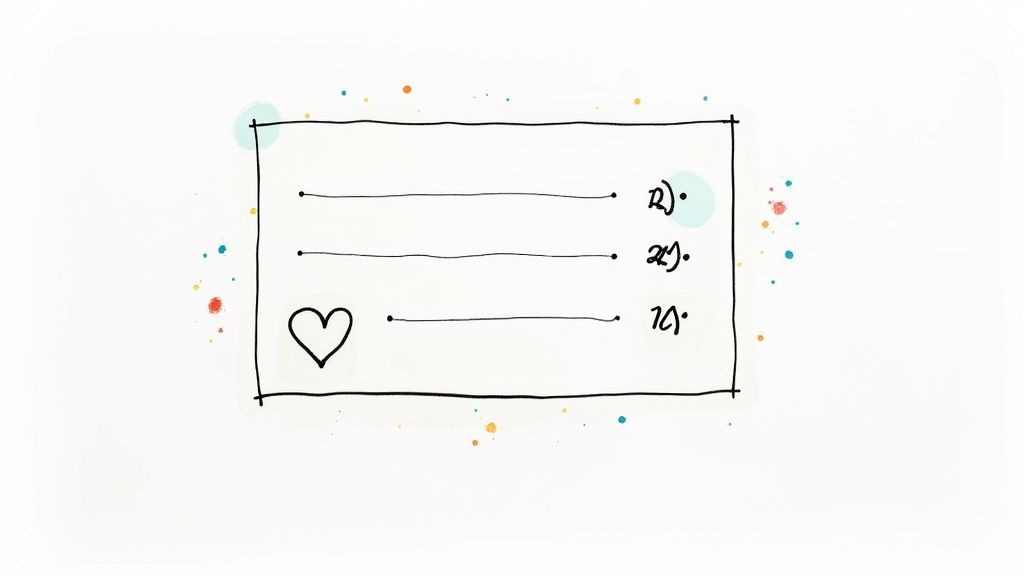
The Most Important Ratio in Ecommerce
Your CLV figure is a great start, but it doesn't paint the whole picture. The true measure of your business's health and profitability is the CLV to Customer Acquisition Cost (CAC) ratio. This ratio is brilliantly simple: it shows how much revenue you earn from a customer compared to what you spent to get them in the door. It’s the ultimate pulse check for your business model.
If your ratio is 1:1, you're just breaking even on your marketing spend. This isn't a sustainable path, as you're essentially buying customers for zero long-term profit. A healthy target for most ecommerce businesses is a 3:1 ratio. This means for every $1 you put into acquiring a customer, you get $3 back over their lifetime. The top players in the game often push this to 5:1 or even higher. Knowing this number is your first step toward smarter investments.
What Does "Good" CLV Actually Look Like?
So, what are the numbers to aim for? Industry data suggests the average customer lifetime value hovers between $100 and $300, but this can vary wildly depending on your niche. The more universal goal is that healthy 3:1 CLV:CAC ratio. If it costs you $50 to acquire a customer, your CLV needs to be at least $150 to build a profitable engine.
Here’s another key insight: customers who engage with you across multiple channels—like your website, social media, and email list—tend to have a 30% higher CLV than those who stick to just one. This proves that creating an integrated, multi-channel experience isn't just a nice-to-have; it's a direct path to higher profits. You can dive deeper into these figures with these valuable customer lifetime value statistics to see how you stack up.
Setting Your Own Benchmarks
While industry averages are useful, getting hung up on them can be misleading. A store selling high-end furniture will naturally have a different CLV profile than a brand selling subscription coffee. The most effective approach is to set benchmarks that are specific to your business and goals.
To help you get started, here's a table that breaks down key metrics into performance tiers. Think of this as your internal report card for customer value.
| Industry CLV Benchmarks and Ratios | | :--- | :--- | :--- | :--- | :--- | | Metric | Action Required | Good | Excellent | Industry Leader | | CLV:CAC Ratio | Below 2:1 | 3:1 | 4:1 | 5:1+ | | Repeat Purchase Rate | Below 20% | 25-30% | 30-40% | 40%+ | | Purchase Frequency (Annual) | 1-2 times | 3-4 times | 5-6 times | 7+ times | | Avg. Time Between Purchases | Over 180 days | 90-120 days | 60-90 days | <60 days |
This table provides clear, data-driven goals. Calculate where your brand currently stands for each metric. If your CLV:CAC ratio is stuck at 2:1, you now have a concrete mission: implement strategies that push it toward the 3:1 "Good" column. This gives you a clear target to aim for as we dive into the specific tactics next.
Email Marketing That Actually Builds Customer Value
When you think about how to increase customer lifetime value ecommerce, email is still one of your best friends. But let’s be real: most brands are doing it wrong. Their approach often feels like a constant barrage of "10% off!" newsletters and robotic automated messages. This doesn't build value; it just creates more inbox clutter.
The real shift happens when you stop thinking about "blasting a list" and start focusing on "nurturing a relationship," one email at a time. This means moving past one-off campaigns and embracing automated email sequences, or "flows," that meet customers right where they are. These emails should feel less like a sales pitch and more like a helpful, personal note that anticipates needs and makes your customer feel seen.
Automation That Feels Human
The goal here isn't just about being efficient; it's about creating genuine connections at scale. A well-designed email flow can turn a one-time buyer into a loyal fan by responding to their actions, not just a pre-set calendar.
For example, look at this automation dashboard from Mailchimp. It shows how you can visually map out these customer journeys.

What a visual editor like this really shows is the power of "if-then" logic. You’re not just sending a fixed series of emails. You're building a responsive system that changes based on how a customer interacts with your brand. That level of personalization makes automation feel more like a conversation and less like a machine.
Key Email Flows That Drive CLV
You don't need a dozen complicated automations to see results. Just focusing on a few core flows can make a huge difference in how often customers buy and how much they spend.
Here are the essential email flows every ecommerce store should set up:
- The Post-Purchase Thank You & Education Flow: This is your golden opportunity to tackle buyer's remorse and pave the way for their next purchase. Go beyond the standard transactional receipt. Send a 3-5 email sequence that genuinely thanks them, shows them how to get the most from their product, and subtly points to complementary items. For a skincare brand, this could be an email two weeks post-delivery asking how their skin is doing and recommending a serum that works perfectly with the moisturizer they just bought.
- The Win-Back Campaign: Every store has customers who fade away. A smart win-back flow can re-engage a good chunk of them. Instead of a generic "We miss you!" discount, offer something of value. Acknowledge they've been gone for a bit and show them what’s new and exciting. You could highlight top-rated products or recent brand news. The idea is to remind them why they liked you in the first place.
- The CLV-Segmented VIP Flow: Not all customers are the same. You need to identify your top 5-10% of customers based on their spending and how often they buy, and then treat them like gold. Create a special segment for these high-value customers and send them exclusive content, early access to new products, or even surprise gifts. This makes your best customers feel truly appreciated, which is key to keeping them around.
Putting these flows in place requires some work upfront, but the return in long-term customer value is massive. For a deeper dive, you can check out some of the most effective ecommerce email flows that top brands are using. Always remember to lead with value. Every single email should answer the customer's unspoken question: "What's in it for me?"
Social Media For Long-Term Customer Relationships
So far, we’ve dug into how email can nurture your customers, but what about its more public-facing counterpart? I'm talking about social media. Too many ecommerce brands treat their social channels like a digital billboard, just running flashy campaigns to get new eyeballs. That's a huge missed opportunity. Your social platforms are incredible tools for building a genuine community and deepening relationships with the people who already love your stuff.
It all comes down to shifting from a transactional mindset to a relational one. Instead of just shouting about your latest sale, you can create a space where customers feel connected to your brand and each other. When you nail this, you’re not just selling products; you’re building a tribe. This is how one-time buyers become loyal advocates who not only spend more over time but also become your most powerful marketing force.
Beyond the Sale: Building a Community Hub
The goal here isn't to constantly push for the next purchase. It's about staying top-of-mind by providing value that doesn't always come with a discount code. This could mean sharing helpful tips related to your products, celebrating customer stories, or just starting a fun conversation. When you make your social media a destination instead of just an advertisement, people have a reason to stick around.
A powerful way to do this is by creating a dedicated community space, like a private Facebook Group or a Discord server, exclusively for your customers. Imagine a sustainable activewear brand creating a group where customers share workout wins, healthy recipes, and tips for living a more eco-friendly lifestyle. This builds a real sense of belonging and turns customers into a support system for one another, all centered around your brand.
Turn Customers into Your Best Content Creators
One of the most authentic ways to build trust and encourage repeat sales is through User-Generated Content (UGC). Think about it: when potential or existing customers see real people genuinely enjoying your products, it’s way more convincing than any polished ad you could create. But you can't just cross your fingers and hope people post. You need to actively encourage and reward it.
Here’s a simple approach that works like a charm:
- Create a Clear Branded Hashtag: Make it unique, memorable, and easy to spell. Put it everywhere—in your Instagram bio, on your packaging, and in your post-purchase emails.
- Run Contests and Giveaways: Offer a monthly prize, like a gift card, for the best photo featuring your product. This gamifies the experience and gives you a steady stream of amazing UGC to work with.
- Showcase, Showcase, Showcase: Regularly feature customer photos on your feed, in your Stories, and even on your product pages. Always remember to tag the original creator to give them their well-deserved shout-out. This public recognition makes customers feel seen and encourages others to join in.
This strategy creates a self-perpetuating cycle. More UGC leads to more social proof, which builds trust, encourages more sales, and ultimately, generates even more UGC.
Social Media as a Customer Service Powerhouse
Your social channels are often the first place a customer will go to voice a concern or complaint. How you handle these public interactions can either make or break customer loyalty. A quick, empathetic response can turn a negative situation into a powerful demonstration of your brand’s commitment to its customers.
Around 84% of consumers expect a response within 24 hours when they post a complaint on social media. Responding quickly and transparently shows you’re listening and that you actually care. This public problem-solving doesn't just retain the customer with the issue; it also shows everyone else watching that you stand behind your products and value your community. That kind of trust is what great customer relationships are built on.
Personalization That Drives Real Customer Value
We've talked about using email and social media to build relationships, but the real secret to boosting customer lifetime value is making every interaction feel personal. Shoppers today don't just want good products; they expect you to get them. The good news is you don't need a huge tech team to start. Real, effective personalization is simply about using the data you already have to be more thoughtful and relevant.
When you nail personalization, it directly lifts the core CLV metrics. It increases purchase frequency by showing customers what they need right when they need it, and it boosts average order value by suggesting relevant add-ons. It’s the difference between a customer feeling like a number on a spreadsheet and feeling like your most valued client. That shift in perception is what builds the loyalty that drives long-term revenue.
Making Personalization Practical
The key is to start small and focus on areas with the biggest impact. Forget complex algorithms for a moment and just think about the customer's journey. Where are the moments you can add a touch of personal relevance? It could be as simple as segmenting your email list by past purchase categories or creating targeted pop-ups for returning visitors.
The most successful brands weave personalization into every touchpoint. This creates a cohesive and intelligent experience that makes customers feel like you're paying attention. True personalization shows up in your revenue reports because it makes shopping easier and more enjoyable. You can find some fantastic ecommerce personalization examples from brands that have mastered this, proving how small, thoughtful changes can lead to big wins.
Product Recommendations That Actually Work
One of the most powerful personalization tactics is the product recommendation engine. We’ve all seen this in action on sites like [Amazon], where the "Customers who bought this also bought" section is a masterclass in cross-selling.
Here's a look at how Amazon presents these recommendations directly on a product page.
This isn’t just a random assortment of products; it’s a carefully curated selection based on the shopping behaviors of millions of users. The insight here is clear: by showing customers relevant, complementary items, Amazon makes it incredibly easy for them to add more to their cart, directly increasing the average order value for that session. This strategy is a cornerstone of how they increase customer lifetime value in ecommerce.
For your own store, you can achieve this with simple app integrations that analyze purchase history. Here are a few ways to get started:
- "Complete the Look" Bundles: If someone buys a dress, recommend the matching shoes and accessories on the product page or in a post-purchase email.
- Refill Reminders: For consumable products like skincare or coffee, send a personalized email when the customer is likely running low, based on their purchase date. This is a simple but incredibly effective way to secure a repeat purchase.
- "Inspired by Your Browsing" Sections: Use a customer’s recent browsing activity to show them similar products they might have missed.
Personalization isn’t about being creepy; it’s about being helpful. It’s about anticipating your customer’s needs and presenting them with solutions before they even have to ask. By removing the friction of discovery and making every customer feel understood, you build a powerful foundation for a longer, more valuable relationship.
Measuring, Testing, And Scaling Your CLV Wins
Putting these email and social strategies into motion is exciting, but it’s only half the battle. The real magic happens when you start measuring what actually works, testing new ideas, and then scaling those wins. This is how you shift from simply trying things to building a predictable system for growth and genuinely increase customer lifetime value in ecommerce.
The first move is knowing what to track. Your main CLV number is your North Star, but to get insights you can act on, you need to dig a little deeper. Think of it like a doctor looking beyond just your temperature; they need to check your blood pressure and heart rate to get the full picture.
Key Metrics for a Clearer Picture
Instead of getting lost in a sea of data, focus on a few key metrics that tell you why your CLV is changing. These are your diagnostic tools.
- Repeat Purchase Rate: This one's straightforward: what percentage of your customers come back to buy again? It's the most direct indicator of whether your retention efforts are hitting the mark.
- Time Between Purchases: How long does it typically take for a customer to make their next purchase? If you can shorten this cycle with a well-timed email or a relevant social post, your CLV will naturally climb.
- AOV by Cohort: Don't just look at your overall Average Order Value. Group customers by the month they were acquired and see how their AOV changes on their second, third, or fourth purchase. Are customers from January spending more over time than those from February? This tells you if your upselling and cross-selling is effective.
- Customer Health Score: This is a bit more advanced but incredibly powerful. You can create a simple score based on signals like recent purchase activity, email engagement, and website visits. It’s like an early-warning system that helps you spot at-risk customers before they drift away for good.
Running Tests That Actually Move the Needle
With your key metrics ready, it's time to experiment. When you're A/B testing for CLV, the goal isn't just a one-time conversion bump; you're trying to influence long-term behavior.
A perfect place to start is your post-purchase email flow. Instead of just testing a subject line for a higher open rate, design a test to see which email sequence leads to a better repeat purchase rate within 90 days.
Here’s a practical test you could run right now:
| A/B Test for Post-Purchase Flow | | :--- | :--- | | Control Group (A) | A standard 3-email sequence: Order Confirmation -> Shipping Confirmation -> "How Was It?" Review Request. | | Test Group (B) | An enhanced 5-email sequence: Order Confirmation -> "How to Use" Guide -> User-Generated Content Showcase -> Personalized Cross-Sell Offer -> Review Request. |
After running the test, you'd compare the 90-day repeat purchase rate and AOV for both groups. If Group B shows a 15% higher repeat purchase rate, you've found a clear winner. You've discovered a concrete way to increase customer lifetime value in ecommerce, backed by your own data.
Scaling Your Wins and Communicating Value
Once you find a winning strategy, don't just celebrate—scale it. If that enhanced post-purchase flow worked, make it the new default for every customer. If a specific type of social media contest sparked a surge in sales from existing customers, turn it into a quarterly event.
Finally, share your success. It’s one thing to know you’ve made an impact, but it’s another to prove it. When you can walk into a meeting with a chart that says, "This new email flow increased our 90-day repeat purchase rate by 15%," you build incredible momentum. It demonstrates that focusing on existing customers isn't just a "nice-to-have" activity but a core driver of profitable, sustainable growth.
